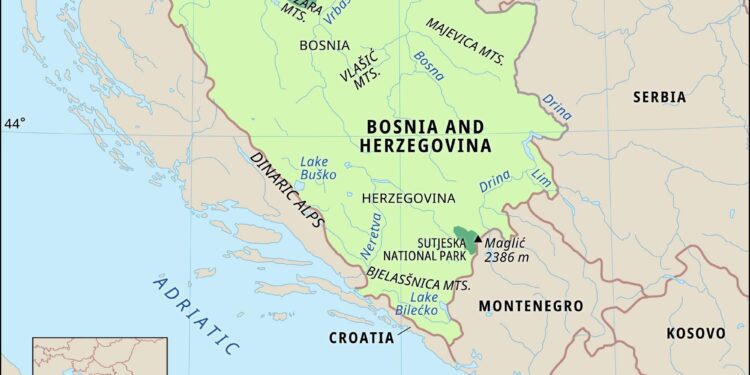Bosnia and Herzegovina continues to grapple with complex dynamics in migrant mobility, as new developments unfold across the region. The latest “Migrant Mobility Situation Report” for June 2025, published by ReliefWeb, offers a comprehensive overview of the current challenges and trends affecting migrants and displaced populations within the country. This report highlights key shifts in migration flows, border management responses, and humanitarian needs, underscoring the ongoing impact on Bosnia and Herzegovina’s social and political landscape. As the situation evolves, stakeholders are calling for coordinated action to address urgent vulnerabilities and ensure protection for those on the move.
Migrant Influx Trends and Border Management Challenges in Bosnia and Herzegovina
Recent months have witnessed a sharp increase in migrant arrivals along Bosnia and Herzegovina’s northern and eastern corridors, reflecting broader regional displacement patterns. Many individuals and families are fleeing ongoing conflicts, economic instability, and environmental crises in their home countries, making Bosnia a critical transit point into the European Union. The influx has placed significant pressure on border authorities who are contending with limited infrastructure, fluctuating migrant flows, and evolving smuggling networks. Reports indicate that informal crossings have surged by 35% compared to the previous quarter, with hotspots concentrated near the Una-Sana Canton and the Republika Srpska border areas.
Border management teams face numerous obstacles, including insufficient personnel and lack of coordination between national and local agencies. Furthermore, humanitarian agencies report that many arriving migrants suffer from exhaustion and inadequate basic services, highlighting the urgent need for enhanced reception capacities. Below is an overview of key challenges observed during the current reporting period:
- Increased irregular crossings: New routes bypassing official checkpoints complicate surveillance efforts.
- Lack of real-time data sharing: Gaps in information flow hinder rapid response.
- Infrastructure constraints: Temporary shelters exceed capacity, affecting living conditions.
- Security concerns: Reports of rising tensions between migrant groups and local communities.
| Border Sector | Estimated Monthly Arrivals | Primary Nationalities | Capacity Utilization (%) |
|---|---|---|---|
| Bihać Sector | 1,200 | Syrian, Afghan | 110 |
| Tuzla Sector | 850 | Pakistani, Iraqi | 95 |
| Zvornik Sector | 600 | Bangladeshi, Iranian | 80 |
Humanitarian Response Efforts and Access to Essential Services Among Migrants
Humanitarian agencies operating within Bosnia and Herzegovina continue to face significant challenges in ensuring sustained access to essential services for migrants traversing the region. Despite growing numbers, coordination between governmental institutions and international organizations has enabled the provision of critical support, including shelter, food distribution, and medical assistance. However, logistical constraints and limited infrastructure, particularly in remote border areas, hamper the efficiency and reach of these efforts. As a result, many migrants remain vulnerable to harsh weather conditions and health risks while en route.
Key components of the ongoing response include:
- Deployment of mobile health clinics providing immediate medical care.
- Establishment of transit centers with increased capacity to prevent overcrowding.
- Distribution of hygiene kits and nutritional supplies to reduce disease outbreaks.
- Enhanced legal aid services to support asylum seekers and vulnerable individuals.
| Service | Coverage Area | Current Capacity |
|---|---|---|
| Mobile Health Clinics | Bosanski Petrovac & Una-Sana Canton | 5 units operational |
| Transit Centers | Velika Kladuša and Bihać | 1,200 beds total |
| Food & Hygiene Kits | National distribution | 8,000 kits/month |
| Legal Aid | Una-Sana Canton | 200 clients/month |
Policy Recommendations for Enhancing Protection and Mobility Solutions
To address the increasing challenges faced by migrants, stakeholders must prioritize strengthening protection frameworks through enhanced legal support and community-based interventions. Implementing accessible legal aid clinics at border crossings and transit points can drastically reduce vulnerabilities linked to unlawful detention and exploitation. Additionally, expanding multilingual outreach programs will ensure that migrants are better informed about their rights and available services, fostering environments where they can safely express concerns without fear of reprisal.
Improving mobility solutions requires coordinated investment in infrastructure and technological innovation. Establishing multi-sectoral partnerships between government agencies, international organizations, and civil society can facilitate the development of streamlined registration systems and secure transport corridors. These efforts should be complemented by well-trained mobility officers tasked with guiding migrants effectively while mitigating risks associated with irregular movement. Below is a summary of key recommended actions:
- Creation of mobile legal aid units across hotspot areas
- Deployment of real-time data platforms for tracking migration flows
- Investment in safe transit hubs equipped with healthcare and counseling
- Regular training programs for frontline responders on human rights standards
- Promotion of bilateral agreements to facilitate orderly and dignified movement
| Recommendation | Expected Impact | |||||||
|---|---|---|---|---|---|---|---|---|
| Mobile Legal Aid Units | Enhanced access to justice and reduced rights violations | |||||||
| Real-Time Data Platforms | Improved coordination and rapid response capabilities | |||||||
| Safe Transit Hubs |
| Recommendation | Expected Impact |
|---|---|
| Mobile Legal Aid Units | Enhanced access to justice and reduced rights violations |
| Real-Time Data Platforms | Improved coordination and rapid response capabilities |
| Safe Transit Hubs |
















